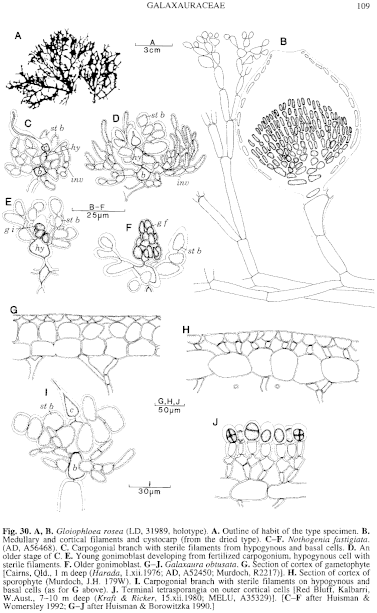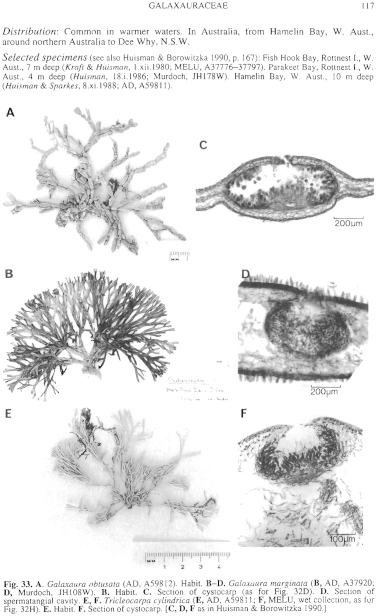|
|
|
|
|
|||||||||||
|
Electronic Flora of South Australia Species Fact Sheet
Phylum Rhodophyta – Class Florideophyceae – Order Nemaliales – Family Galaxauraceae
Selected citations: Harvey 1862: pl. 228; 1863: synop.: xxxviii. Huisman & Borowitzka 1990: 161, figs 28–33, 35–38. Levring 1953: 514. Millar 1990: 303, fig. 5D, E.
Synonyms
Corallina obtusata Ellis & Solander 1786: 113, pl. 22 fig. 2.
Galaxaura dolicarthra Kjellman 1900: 85, pl. 18 figs 33–44, pl. 20 fig. 55.
Galaxaura robusta Kjellman 1900: 85, p1. 18 figs 19–32, pl. 20 fig. 42.
Galaxaura tumida Kjellman 1900: 86, pl. 19 figs 1–7, pl. 20 fig. 49. Lucas 1935: 217.
Galaxaura umbellata Lamouroux 1816: 262. Bailey 1913: 822. Lucas 1931: 53. May 1965: 359. Sonder 1881: 25.
Thallus (Fig. 33A) dark red to chalky grey-red, 5–14 cm high, subdichotomously branched and clearly segmented, segments ovoid to elongate, rounded at both ends, 7–19 mm long, 3–5 mm broad. Holdfast discoid, 2–10 mm across; epilithic. Structure of gametophyte cortex (Fig. 30G) three layered, the inner two layers of large, colourless cells that may fuse laterally, the outer layer of pigmented cells 20–30 µm in diameter. Cortex in tetrasporophyte (Fig. 30H) of three layers: an inner layer of inflated, laterally adherent, colourless cells; a middle layer of smaller, rhodoplastic cells which supports the outer layer of densely rhodoplastic, hemispherical cells, usually 2 per supporting cell. Rhodoplasts campanulate with a central pyrenoid.
Reproduction: Sexual thalli dioecious. Carpogonial branches (Fig. 30I) 3-celled, borne near apices in place of a cortical filament, with the hypogynous cell producing four large-celled branches and the basal cell 3–4 smaller-celled branches. Cystocarps 300–600 µm in diameter with gonimoblast filaments forming the cystocarp wall and producing inwardly directed obovoid carposporangia 35–45 µm long and 18–20 µm in diameter. Male conceptacles 270–400 µm in diameter with spermatangia (8–9 µm long and 5–6 inn in diameter) produced terminally and laterally from filaments projecting into the cavity.
The tetrasporophyte with subspherical to ovoid, cruciately divided tetrasporangia (Fig. 30J), 30–35 µm long and 25–35 µm in diameter, borne in surface sori on the outer cortical layer. After spore release the initial elongates slightly and produces further tetrasporangia within the old sporangial wall, which remains as a collar around the initial.
Type from the Bahama Is, West Indies; lost, lectotypified by Ellis & Solander 1786, pl. 22 fig. 2 (see Papenfuss et al. 1982).
Selected specimens: (see also Huisman & Borowitzka 1990, p. 162). Green I., near Rottnest I., W. Aust. (Huisman, 6.ii.1989; Murdoch, JH179W). Hamelin Bay, W. Aust., 10 m deep (Huisman & Sparkes, 8.xi.1988; AD, A59812). Albany, W. Aust., 20 m deep at Cheynes III wreck site, Michaelmas I. (Huisman, 5.iv.1993; Murdoch JH273).
Distribution: Tropics in general, occasionally in temperate areas.
In Australia from Albany, W. Aust., around northern Australia to Lake Macquarie, N.S.W.
Taxonomic notes: Galaxaura obtusata is more commonly found in subtropical and tropical regions, but extends as far south as Albany on the Western Australian coast. Two other moniliform species of Galaxaura have been described from Australian waters by Kjellman (1900) (Galaxaura dolicarthra from Lake Macquarie, N.S.W. and Galaxaura tumida from "Habrone Bay", Qld). These have been placed in synonymy with G. obtusata by Huisman & Borowitzka (1990).
References:
BAILEY, F.M. (1913). Comprehensive Catalogue of Queensland Plants. (Govt Printer: Brisbane.)
ELLIS, J. & SOLANDER, D. (1786). The Natural History of many curious and uncommon zoophytes, collected from various parts of the globe, by the late John Ellis, Esq. F.R.S. (B.White & Son: London.)
HARVEY, W.H. (1862). Phycologia Australica. Vol. 4, Plates 181–240. (Reeve: London.)
HARVEY, W.H. (1863). Phycologia Australica. Vol. 5, Plates 241–300, synop., pp. i-lxxiii. (Reeve: London.)
HUISMAN, J.M. & BOROWITZKA, M.A. (1990). A revision of the Australian species of Galaxaura (Rhodophyta, Galaxauraceae), with a description of Tricleocarpa gen. nov. Phycologia 29, 150–172.
KJELLMAN, F.R. (1900). Om Floridé-slägtet Galaxaura dess organografi och systematik. K. Svenska Vetensk. Akad. Handl. 33(1), 1–109, Plates 1–20.
LAMOUROUX, J.V.F. (1816). Histoire des Polypiers Coralligènes Flexibles. (Poisson: Caen.)
LEVRING, T. (1953). The marine algae of Australia. I. Rhodophyta: Goniotrichales, Bangiales and Némalionales. Arkiv för Bot. Ser. 2, 2, 457–530.
LUCAS, A.H.S. (1931). Notes on Australian marine algae. VI. Proc. Linn. Soc. N.S.W. 56, 407–411, Plates 23–27.
LUCAS, A.H.S. (1935). The marine algae of Lord Howe Island. Proc. Linn. Soc. N.S.W. 60, 194–232, Plates 5–9.
MAY, V. (1965). A census and key to the species of Rhodophyceae (red algae) recorded from Australia. Contr. N.S.W. natn. Herb. 3, 349–429.
MILLAR, A.J.K. (1990). Marine Red Algae of the Coffs Harbour Region, northern New South Wales. Aust. Syst. Bot. 3, 293–593.
PAPENFUSS, G.F., MSHIGENI, K.E. & CHIANG, Y.-M. (1982). Revision of the red algal genus Galaxaura with special reference to the species occurring in the western Indian Ocean. Bot. Mar. 25, 401–444.
SONDER, O.W. (1881). In Mueller, F., Fragmenta Phytographiae Australiae. Supplementum ad volumen undecinum: Algae Australianae hactenus cognitae, pp. 1–42, 105–107. (Melbourne.)
The Marine Benthic Flora of Southern Australia Part IIIA complete list of references.
Publication:
Womersley, H.B.S. (14 January, 1994)
The Marine Benthic Flora of Southern Australia
Rhodophyta. Part IIIA, Bangiophyceae and Florideophyceae (to Gigartinales)
Reproduced with permission from The Marine Benthic Flora of Southern Australia Part IIIA 1994, by H.B.S. Womersley. Australian Biological Resources Study, Canberra. Copyright Commonwealth of Australia.
Illustrations in Womersley Part IIIA, 1994: FIGS 30 G–J, 33A.

Figure 30 enlarge
Fig. 30. A, B. Gloiophloea rosea (LD, 31989, holotype). A. Outline of habit of the type specimen. B. Medullary and cortical filaments and cystocarp (from the dried type). C–F. Nothogenia fastigiata. (AD, A56468). C. Carpogonial branch with sterile filaments from hypogynous and basal cells. D. An older stage of C. E. Young gonimoblast developing from fertilized carpogonium, hypogynous cell with sterile filaments. F. Older gonimoblast. G–J. Galaxaura obtusata. G. Section of cortex of gametophyte [Cairns, Qld., 1 m deep (Harada, 1.xii.1976; AD, A52450; Murdoch, R2217)]. H. Section of cortex of sporophyte (Murdoch, J.H. 179W). I. Carpogonial branch with sterile filaments on hypogynous and basal cells (as for G above). J. Terminal tetrasporangia on outer cortical cells [Red Bluff, Kalbarri, W.Aust., 7-10 m deep (Kraft & Ricker, 15.xii.1980; MELU, A35329)1. [C–F after Huisman & Womersley 1992; G–J after Huisman & Borowitzka 1990.]

Figure 33 enlarge
Fig. 33. A. Galaxaura obtusata (AD, A59812). Habit. B–D. Galaxaura marginata (B, AD, A37920; D, Murdoch, JH108W). B. Habit. C. Section of cystocarp (as for Fig. 32D). D. Section of spermatangial cavity. E, F. Tricleocarpa cylindrica (E, AD, A59811; F, MELU, wet collection, as for Fig. 32H). E. Habit. F. Section of cystocarp. [C, D, F as in Huisman & Borowitzka 1990.]

|
Email Contact: State Herbarium of South Australia |

|